Centauri Dreams
Imagining and Planning Interstellar Exploration
Close Stellar Encounters and Earth’s Orbit
Galaxies look fixed in astronomical photos, but of course they’re dynamic systems ever in motion. The closest stars to Earth at Alpha Centauri will eventually close to within about 3 light years if we wait thirty thousand years or so. After that, as the system moves away again, Ross 248 will emerge as the closest interstellar target, closing to about the same distance before moving off into the night. But that will require waiting a bit longer, on the order of another 6000 years. We might also keep an eye on Gliese 445, which in 46,000 years or so will close to less than 4 light years of the Sun.
So everything is moving all the time, and we can say something more about future encounters. The REsearch Consortium On Nearby Stars (RECONS) has found that within the local 10-parsec volume, 81 percent of the 357 main sequence stars in its stellar census are less than half as massive as the Sun. That’s about the current estimate for the percentage of stars in the galaxy that are M-dwarfs, and we might expect that most close passages to our system have been and will be with this type of star.
The average distance between these stars is 3.85 light years, which again is close to what we see locally, since the Alpha Centauri stars are not far beyond that range from us. In this collection of stars, 232 single-star systems appear, and 85 multiples. This has led to interesting speculations, such as Bradley Hansen and Ben Zuckerman’s work at UCLA arguing that if stars get close enough, interstellar flight between them is more feasible. Suppose a star at 14,000 AU and the prospect seems more workable.
Stars do indeed get that close, as the example of Gliese 710 shows. If we’re patient, we can wait out the 1.3 million years it is projected for this to happen, for this star, on the borderline between M-dwarf and K-class, is headed our way from its current vantage in the constellation Serpens Cauda. As it will eventually be well inside the Oort Cloud, we can imagine quite an impact on cometary orbits and planetary ones as well over the long haul, as the paper I’m about to discuss shows. But before leaving Hansen and Zuckerman, let me mention that they calculate that if we widen the timeframe to a billion years, the likelihood of a star getting as close as 5000 AU is 81 percent.
Now let’s flip the question backward in time. Scholz’s Star (WISE J072003.20-084651.2) moved near our system about 70,000 years ago, reaching by current estimates somewhere between 52,000 AU and 68,000 AU from the Sun. Here we’ve got a binary consisting of an M-dwarf and a probable brown dwarf companion at 0.8 AU.
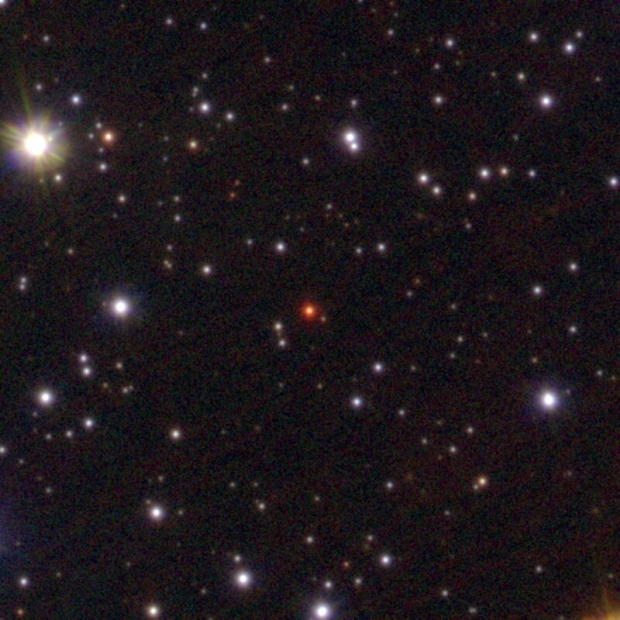
Image: Now about 20 light years away, Scholz’s Star (red star in the center) and its brown dwarf companion passed close to the Solar System and remained within 100,000 AU for a period of roughly 10,000 years. Image Credit: ESO VPHAS / Wikimedia Commons CC BY-SA 4.0.
Nathan Kaib (Planetary Science Institute) and Sean Raymond (Laboratoire d’Astrophysique de Bordeaux, CNRS) have gone to work on the question of passing stars as it relates to the Solar System’s evolution. Study the changes that have occurred in Earth’s climate over the millennia and it appears that fluctuations in the eccentricity of Earth’s orbit are involved. Kaib points to a specific episode that is illuminated by the analysis in this paper:
“One example of such an episode is the Paleocene-Eocene Thermal Maximum 56 million years ago, where the Earth’s temperature rose 5-8 degrees centigrade. It has already been proposed that Earth’s orbital eccentricity was notably high during this event, but our results show that passing stars make detailed predictions of Earth’s past orbital evolution at this time highly uncertain, and a broader spectrum of orbital behavior is possible than previously thought.”
So we’re digging into the history of our planet’s orbit, along with that of the other planets. The authors’ research shows that stellar encounters are not uncommon. A star passes within 50,000 AU on average every million years, and within 10,000 AU every 20 million years. To study the matter, Kaib and Raymond use a hybrid integrator – a set of specialized numerical methods – called MERCURY to simulate these encounters, under conditions described in the paper. The computer runs show that orbital changes to Earth do indeed result, or are at least accelerated, by perturbations from other stars.
Complicating these calculations is the fact that orbital evolution is chaotic, so that beyond timescales on the order of 100 million years, it is impossible to do more than characterize it statistically. The authors point out that even the long-term stability of the Solar System is not guaranteed, as over the Sun’s lifetime there is a 1 percent chance that Mercury will be lost by collision with either the Sun or Venus.
Earth’s past or future orbital evolution can only be confidently predicted inside a time horizon much shorter than Earth’s age, as small uncertainties in current planetary orbits eventually lead to dramatically divergent behavior. The time horizon set by the internal chaos among the Sun’s eight planets is ∼70 Myr, but additional strong chaos resulting from encounters between large asteroids shortens the horizon by another ∼10 Myr (Laskar et al. 2011b). However, inside this time horizon, backward integration of the Sun’s planets has been used to predict the detailed past orbital evolution of the Earth (Laskar et al. 2004).
Such perturbations make it difficult to pin down Earth’s orbital evolution the farther back in time we go, and it appears as well that perturbations from asteroid interactions are less significant than stellar encounters in degrading our ability to predict orbital changes. That’s useful information, because most simulations of the long-term evolution of the planetary orbits have modeled the Solar System in isolation. Changes in Earth’s orbit can also be the result of interactions with the giant planets, but a passing star can affect their orbits, which in turn impacts Earth’s orbital trajectory. Indeed, adding the giant planets to the simulations shows what a major factor these worlds are on Earth’s orbit once they themselves are perturbed by the passing star. Kaib and Raymond call them “a dynamical link that ultimately allows the Milky Way’s stars to influence the long-term evolution of Earth’s orbit.”
The paper turns to a specific encounter, that with the star HD 7977, which is a G-class star in Cassiopeia now some 250 light years away. 2.8 million years ago, this star moved past the Solar System at about 27 kilometers per second, its trajectory taking it somewhere in the neighborhood of 13,200 AU from the Sun, although the authors point out the wide cone of uncertainty about the distance, which may have been as little as 3900 AU. The ‘impulse gradient’ that shows the level of perturbation to the planets was over an order of magnitude higher than the norm during this time.
Working this into their models, the authors find that the median value of 13,200 AU would have had little effect on the Solar System’s long term chaotic evolution, but a passage at 3900 AU would have affected the eccentricity of Earth’s orbit. This is in addition, of course, to whatever effect such a close passage would have on Oort Cloud objects. A passage at 3900 AU would be one of the ten most powerful encounters experienced in the history of our system given the star’s above average mass and an encounter velocity that is below the average.
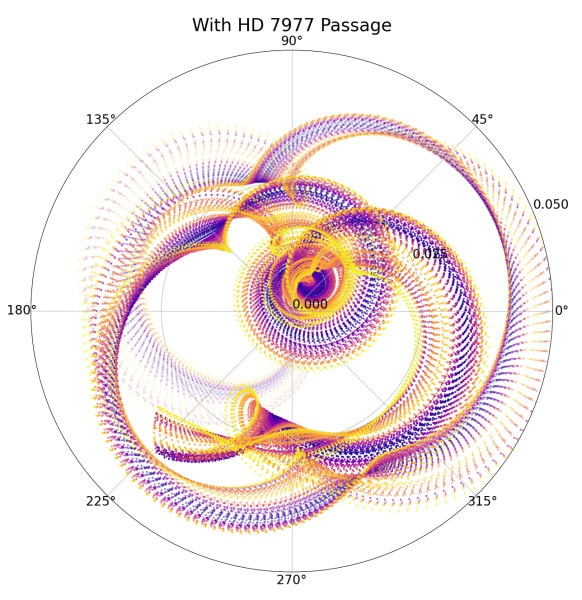
Image: Illustration of the uncertainty of Earth’s orbit 56 million years ago due to a potential past passage of the Sun-like star HD7977 2.8 million years ago. Each point’s distance from the center corresponds to the degree of ellipticity of Earth’s orbit, and the angle corresponds to the direction pointing to Earth’s perihelion, or closest approach distance to the Sun. 100 different simulations (each with a unique color) are sampled every 1,000 years for 600,000 years to construct this figure. Every simulation is consistent with the modern Solar System’s conditions, and the differences in orbital predictions are primarily due to orbital chaos and the past encounter with HD 7977. Credit: N. Kaib/PSI.
What’s notable here is that the authors have demonstrated that stellar encounters can be significant drivers for system evolution, an area not as widely studied as the internal dynamics of the Solar System. Here’s their conclusion:
…stellar encounters significantly accelerate the chaotic diffusion of Earth’s orbit and the time back to which numerical simulations can confidently predict Earth’s orbital evolution is ∼10% shorter than previously thought. Second, this chaotic divergence that stellar passages impart on Earth’s orbit results from their perturbations to the giant planets’ orbits, and these perturbations roughly scale with the velocity impulse gradients of stellar encounters. Third, the known encounter with HD 7977 2.8 Myr ago has the potential to unlock new sequences of Earth’s past orbital evolution beyond 50 Myr ago that have not been considered or generated in previous modeling efforts. Although it takes tens of Myr for the effects of stellar passages to significantly manifest themselves, the long-term orbital evolution of the Earth and the rest of the planets is linked to these stars.
We seem to have overestimated our ability to describe Earth’s orbital state in earlier eras given what we’re learning about the disruptive effects of stellar encounters. These close brushes with other stars can potentially cause changes in eccentricity that have been overlooked. Factoring stellar encounters into future models is going to be complicated, and necessary.
The paper is Kaib & Raymond, “Passing Stars as an Important Driver of Paleoclimate and the Solar System’s Orbital Evolution,” Astrophysical Journal Letters 962 (14 February 2024) L28 (full text). The Hansen and Zuckerman paper I mentioned above is “Minimal conditions for survival of technological civilizations in the face of stellar evolution,” Astronomical Journal Col. 161, No. 3 (25 February 2021) 145 (full text). See also Bobylev & Bajkova, “Search for Close Stellar Encounters with the Solar System Based on Data from the Gaia DR3 Catalogue,” Astronomical Letters Vol. 48 (13 February 2023), 542-549 (abstract).

Musings on Red Dwarf Planets
I’m going to start in the Kuiper Belt this morning before going further out, because the news that the Belt may extend much further than expected reminds us of the nature of exploration. The New Horizons spacecraft, well beyond Pluto’s orbit and approaching 60 AU from the Sun, is finding more dust than expected. Our theoretical models didn’t see that coming. In fact, the dust produced by collisions between Kuiper belt objects was thought to decline as we approached the Belt’s outer edge.
So just where is that outer edge? It had been pegged around 50 AU but now looks more like 80 AU, if not further out, a finding corroborated by the fact that New Horizons scientists have used Earth-based resources like the Subaru Telescope in Hawaii to find numerous KBOs beyond the assumed boundary. Is this a new population of Solar System objects, or are we actually seeing something more mundane, such as radiation pressure pushing inner belt dust further out than would be expected? It takes patient observation to decide, and to re-shape our notions according to hard data.
Which gets me into exoplanet territory, and specifically our understanding of red dwarf stars. Theory is always malleable and yields to observation which, in turn, re-energizes theory. Michaël Gillon (University of Liége), who is among other things the discoverer of the TRAPPIST-1 system, made this point in a recent email exchange. He was responding to my article What We Know Now about TRAPPIST-1 (and what we don’t) with a much needed note of caution. The question of whether rocky planets orbiting M-dwarf stars can retain atmospheres is one of the hottest controversies going. Observations, says Gillon, will tell the tale, not theory, no matter how elegant the latter. After all, we now have JWST, and a new generation of telescopes already under construction to help.
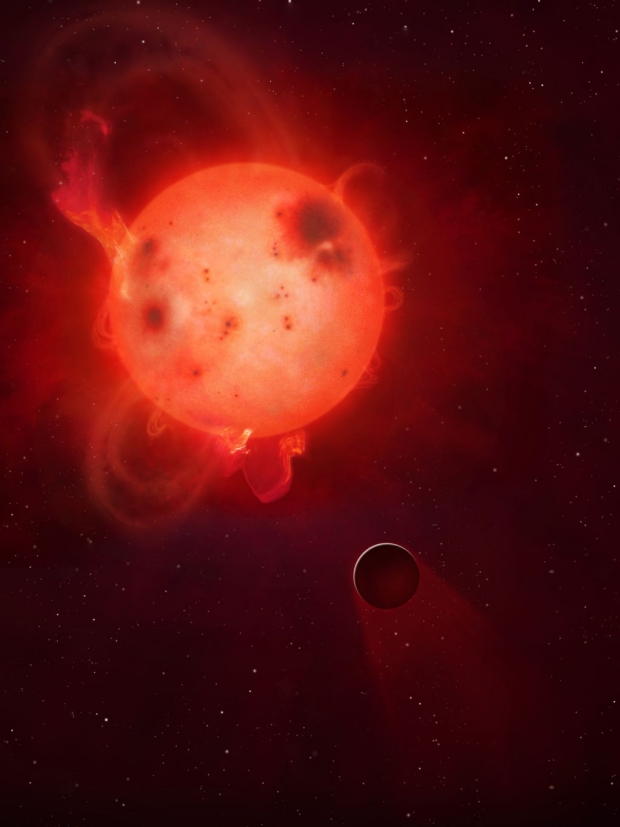
Image: An artist’s concept of Kepler-438b, shown here in front of its violent parent star, a red dwarf. It is regularly irradiated by huge flares of radiation, which could render the planet uninhabitable and possibly strip it of its atmosphere entirely. A variety of mechanisms for depleting the atmosphere of such a planet are now under discussion, using a wide range of models. Image credit: Mark A Garlick / University of Warwick.
On that score, it’s useful to look at a paper that Gillon suggests in his email, a study by Ignasi Ribas and collaborators that appeared in Astronomy & Astrophysics in 2016. The paper does a deep dive into the question of the habitability of Proxima Centauri b, that tantalizingly close Earth-mass planet in the star’s habitable zone. A key issue is whether the extreme dosing of X-ray and ultraviolet radiation such a planet would suffer would compromise a young atmosphere or prevent its existence at all.
There is a lot going on in the Ribas paper, but Gillon pointed me to its discussion of what we might learn from the lesson of our own Earth. Here the essential fuzziness of theory manifests itself, as Ribas and team point out how many uncertainties exist in our estimates of volatile loss, including the telling line “…they rely on complex models that were never confronted to actual observations of massive escape.” Even more telling is the lack of sufficient information about what might prevent such escape:
None of the available models include all the mechanisms controlling the loss rate, for example, the photochemistry of the upper atmosphere and its detailed interaction with the wavelength-dependent stellar emission, non-LTE [Non-Local Thermodynamic Equilibrium] cooling processes, and an accurate description of the outflow beyond the exobase where hydrodynamics no longer apply. Some key data are not known, like the intrinsic planetary magnetic moment, now and in the past, the detailed evolution of the atmospheric composition, of the high-energy spectrum and of stellar wind properties.
Nor do we have hard data on these things even now. Note the term ‘non-LTE cooling’ above. An LTE system is one in thermal equilibrium, maintaining a single temperature. Poking around in the literature, I learn that the lack of thermal equilibrium involves processes that have to be carefully measured to build an accurate profile of an atmosphere, with ramifications for any discussion of its long-term survival. In the absence of such data, it’s telling that other factors remain unknown, including local magnetic conditions and the actual properties of the stellar wind affecting the planet. And we have no good modeling for how volatiles may be distributed between the atmosphere of an M-dwarf planet and the internal processes that can replenish it.
Thus the Ribas paper, although eight years old, remains pertinent to this ongoing discussion, as scientists attack volatile retention in such systems. The authors point out that the protoplanets that built up the early Earth were exposed to a young Sun that was blasting our planet with X-rays, ultraviolet and stellar wind conditions that may equal, and perhaps surpass, what occurred at Proxima b. Note this (italics mine):
The XUV irradiation and stellar wind on the proto-Earth was therefore comparable, and possibly higher, than that of Proxima b. Proxima b spent 100–200 Myr in runaway before entering the HZ, which is longer than the runaway phases experienced by the proto-Earth by a small factor only (<10). Models predict that early Earth suffered massive volatile losses: hydrodynamic escape of hydrogen dragging away heavier species and non thermal losses under strong stellar wind exposure and CMEs (Lammer et al. 2012). Nonetheless, no clear imprint of these losses is found in the present volatile inventory.
The authors point out, then, that geochemical evidence alone shows us no signs of significant depletion of Earth’s inventory of volatiles, which can lead to the possibility that volatile loss was extremely limited under conditions that some of our models would suggest should deplete them radically. If this analysis is correct, then the idea that the planets of red dwarf stars will likely be barren rock stripped of atmospheres is questionable. I come back to Gillon’s point. We’re only going to know from observation, just as we can only know about the extent of the Kuiper Belt through hard data.
Now comes a new paper from Ofer Cohen (University of Massachusetts) and colleagues. Writing in The Astrophysical Journal, the authors again address the TRAPPIST-1 question, this time with a new twist. They’re looking at electric currents that would be produced in the ionosphere of TRAPPIST-1e, a planet that may be in the star’s habitable zone. The question is whether such currents would produce atmospheric heating that would contribute to dissipating the atmosphere entirely.
So this is another stripping mechanism to consider, one produced by the planet’s upper atmosphere encountering the star’s changing magnetic field as the planet proceeds along its orbit. The operative term is ‘Joule heating.’ I only received the paper this morning, so I won’t go too deeply into it. But my early reading suggests that the results from the models used in it point to serious atmospheric loss. This adds to earlier modeling involving the stellar wind and ionized upper atmosphere, some of this conducted by the same authors. The conclusion draws naturally from the modeling:
The JH [Joule heating] is the result of a dissipation of electric current, which is driven by the rapidly varying magnetic field along the planetary orbit. We estimate the JH energy flux on the exoplanet Trappist-1e as well as similar planets orbiting the Sun in close-in orbits. We find that the JH energy flux is larger than the anticipated EUV energy flux at the planet, and it may reach a few percent of the stellar constant energy flux. Such an intense heating could drive a strong atmospheric escape and could lead to a rapid loss of the atmosphere. Thus, the rapid orbital motion of short-orbit exoplanets may exhaust a significant portion of their atmospheres over time.
Again we find useful theories painting a landscape of possibilities. But it’s also true that we lack observational data on the properties of the stellar wind, its evolution over time, and the magnetic fields affecting the planet. The authors call attention to this fact:
VDJH [voltage-driven Joule heating] depends on the variations of the interplanetary magnetic field (IMF) strength along the planetary orbit. Such detailed IMF data are not available for exoplanets (some observations were made for the stellar wind interaction with the interstellar medium; e.g., Wood et al. 2021), nor it is available for short orbits around the Sun (limited data at specific locations are available from the Parker Solar Probe; Raouafi et al. 2023). Due to the lack of observational constraints, we must rely on models to estimate the relevant stellar wind conditions.
Thus energy output, stellar wind and magnetic field changes all factor into a model that suggests atmospheric escape and, like other models, is in need of confirmation with future instrumentation. We can only turn to such observation to begin to understand how diverse theories mesh. I think all the scientists involved in the study of planetary atmospheres around M-dwarfs would agree with this. And headlines in the popular media announcing barren rocks at TRAPPIST-1 are making ongoing investigations into settled science.
Getting too comfortable with theory can mislead us. Recently we saw that the astronomer Otto Struve proposed detecting Jupiter-class worlds in tight orbits around their host stars, only to have the suggestion ignored for decades because ‘hot Jupiters’ simply didn’t fit into then current thinking.
For that matter, nobody thought ‘super-Earths’ were likely, especially in the kind of numbers we’ve found them, nor ‘mini-Neptunes,’ and I doubt many were expecting tiny compact systems of numerous planets, like those Gillon identified at TRAPPIST-1. All in all, I appreciate Gillon’s reminder that patience and data gathering are needed as we explore the question of life around small red stars, an issue that is under deep study but has been by no means resolved. Perhaps the Habitable Worlds Observatory (Habex) will allow a definitive answer for TRAPPIST-1 in the not so distant future.
The Ribas paper is “The habitability of Proxima Centauri b I. Irradiation, rotation and volatile inventory from formation to the present,” Astronomy & Astrophysics 506 (2016), A111 (full text). The Cohen paper is “Heating of the Atmospheres of Short-orbit Exoplanets by Their Rapid Orbital Motion through an Extreme Space Environment,” The Astrophysical Journal 962 (16 February 2020), 157 (full text).

Solar Gravity Lens Mission: Refinements and Clarifications
Having just discussed whether humans – as opposed to their machines – will one day make interstellar journeys, it’s a good time to ask where we could get today with near-term technologies. In other words, assuming reasonable progress in the next few decades, what would be the most likely outcome of a sustained effort to push our instruments into deep space? My assumption is that fusion engines will one day be available for spacecraft, but probably not soon, and antimatter, that quixotic ultimate power source for interstellar flight, is a long way from being harnessed for propulsion.
We’re left with conventional rocket propulsion with gravity assists, and sail technologies, which not coincidentally describes the two large interstellar missions currently being considered for the heliophysics decadal study. Both JHU/APL’s Interstellar Probe mission and JPL’s SGLF (Solar Gravity Lens Focal) mission aim at reaching well beyond our current distance holders, the now struggling Voyagers. The decadal choice will weigh the same question I ask above. What could we do in the near term to reach hundreds of AU from the Sun and get there in relatively timely fashion?
A paper from the JPL effort in Experimental Astronomy draws my attention because it pulls together where the SGLF concept is now, and the range of factors that are evolving to make it possible. I won’t go into detail on the overall design here because we’ve discussed it in the recent past (see for example Building Smallsat Capabilities for the Outer System and Self-Assembly: Reshaping Mission Design for starters). Instead, I want to dig into the new paper looking for points of interest for a mission that would move outward from the Sun’s gravitational lens and, beyond about 650 AU, begin imaging an exoplanet with a factor of 1011 amplification.

Image: This is Figure 1 from the paper. Caption: The geometry of the solar gravity lens used to form an image of a distant object in the Einstein ring. Credit: Friedman et al.
Carrying a telescope in the meter-class, the spacecraft would reach its target distance after a cruise of about 25 years, which means moving at a speed well beyond anything humans have yet attained moving outward from the Sun. While Voyager 1 reached over 17 kilometers per second, we’re asking here for at least 90 km/sec. Remember that the focal line extends outward from close to 550 AU, and becomes usable for imaging around 650 AU. Our spacecraft can take advantage of it well beyond, perhaps out to 1500 AU.
So let’s clear up a common misconception. The idea is not to reach a specific distance from the Sun and maintain it. Rather, the SGLF would continue to move outward and maneuver within what can be considered an ‘image cylinder’ that extends from the focal region outward. This is a huge image. Working the math, the authors calculate that at 650 AU from the Sun, the light (seen as an ‘Einstein ring’ around the Sun) from an exoplanet 100 light years from our system would be compressed to a cylinder 1.3 kilometers in diameter. Remember, we have a meter-class telescope to work with.
Thus the idea is to position the spacecraft within the image cylinder, continuing to move along the focal line, but also moving within this huge image itself, collecting data pixel by pixel. This is not exactly a snapshot we’re trying to take. The SGLF craft must take brightness readings over a period that will last for years. Noise from the Sun’s corona is reduced as the spacecraft moves further and further from the Sun, but this is a lengthy process in terms of distance and time, with onboard propulsion necessary to make the necessary adjustments to collect the needed pixel data within the cylinder.
So we’re in continual motion within the image cylinder, and this gets further complicated by the range of motions of the objects we are studying. From the paper:
Even with the relatively small size of the image produced by the SGL, the spacecraft and telescope must be maneuvered over the distance of tens of kilometers to collect pixel-by-pixel all the data necessary to construct the image… This is needed as the image moves because of the multiple motions [that] are present, namely 1) the planet orbits its parent star, 2) the star moves with the respect to the Sun, and 3) the Sun itself is not static, but moves with respect to the solar system barycentric coordinates. To compensate for these motions, the spacecraft will need micro-thrusters and electric propulsion, the solar sail obviously being useless for propulsion so far from the Sun.
Bear in mind that, as the spacecraft continues to move outward from 650 AU, the diameter of the image becomes larger. We wind up with a blurring problem that has to be tackled by image processing algorithms. Get enough data, though, and the image can be deconvolved, allowing a sharp image of the exoplanet’s surface to emerge. As you would imagine, a coronagraph must be available to block out the Sun’s light.
What to do with the sail used to reach these distances? The mission plan is a close solar pass and sail deployment timed to produce maximum acceleration for the long cruise to destination. Solar sails are dead weight the further we get from the Sun, so you would assume the sail would be jettisoned, although it’s interesting to see that the team is working on ways to convert it into an antenna, or perhaps even a reflector for laser communications. As to power sources for electric propulsion within the image cylinder, the paper envisions using radioisotope thermoelectric generators, which are what will power up the craft’s communications, instruments and computing capabilities.
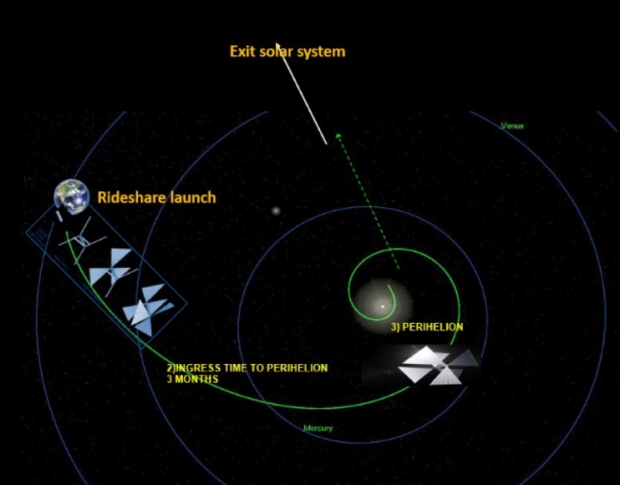
Image: This is Figure 4 from the paper. Caption: Trajectory of the mission design concept for a solar sailcraft to exit the solar system. Credit: Friedman et al./JPL.
Let’s clear up another misconception. If we deploy a sail at perihelion, we are relying on the solar photons delivering momentum to the sail (photons have no mass, but they do carry momentum). This is not the solar wind, which is a stream of particles moving at high velocity out from the Sun, and interesting in its own right in terms of various mission concepts that have been advanced in the literature. The problem with the solar wind, though, is that it is three orders of magnitude smaller than what we can collect from solar photons. What we need, then, is a photon sail of maximum size, and a payload of minimum mass, which is why the SGLF mission focuses on microsats. These may be networked or even undergo self-assembly during cruise to the gravity focus.
The size of a sail is always an interesting concept to play with. Ponder this: The sail mission to Halley’s Comet that Friedman worked on back in the mid-1970s would have demanded a sail that was 15 kilometers in diameter, in the form of a so-called heliogyro, whose blades would have been equivalent to a square sail half a mile to the side. That was a case of starting at the top, and as the paper makes clear, issues of packaging and deployment alone were enough to make the notion a non-starter.
Still, it was an audacious concept and it put solar sails directly into NASA’s sights for future development. The authors believe that based on our current experience with using sails in space, a sail of 100 X 100 square meters is about as large as we are able to work with, and it might require various methods of stiffening its structural booms. The beauty of the new SunVane concept is that it uses multiple sails, making it easier to package and more controllable in flight. This is the ‘Lightcraft’ design out of Xplore Inc., which may well represent the next step in sail evolution. If it functions as planned, this design could open up the outer system to microsat missions of all kinds.
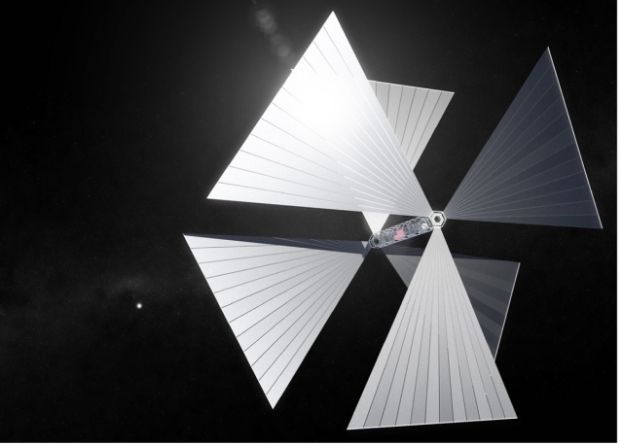
Image: This is Figure 5 from the paper. Caption: Xplore’s Lightcraft TM advanced solar sail for rapid exploration of the solar system. Credit; Friedman et al./JPL.
Pushing out interstellar boundaries also means pushing materials science hard. After all, we’re contemplating getting as close to the Sun as we can with a sail that may be as thin as one micron, with a density less than 1 gram per square meter. The kind of sail contemplated here would weigh about 10 kg, with 40 kg for the spacecraft. The payload has to be protected from a solar flux that at 0.1 AU is 100 times what we receive on Earth, so the calculations play the need for shielding against the need to keep the craft as light as possible. An aluminized polymer film like Kapton doesn’t survive this close to the Sun, which is why so much interest has surfaced in materials that can withstand higher temperatures; we’ve looked at some of this work in these pages.
But the longer-term look is this:
Advanced technology may permit sails the size of a football field and spacecraft the size of modern CubeSats, and coming close to the Sun with exotic materials of high reflectivity and able to withstand the very high temperatures. That might permit going twice as fast, 40 AU/year or higher. If we can do that it will be worth waiting for. With long mission times, and with likely exoplanets in several different star systems being important targets of exploration we may want to develop a low cost, highly repeatable and flexible spacecraft architecture – one that might permit a series of small missions rather than one with a traditional large, complex spacecraft. The velocity might also be boosted with a hybrid approach, adding an electric propulsion to the solar sail.
It’s worth mentioning that we need electric propulsion on this craft anyway as the craft maneuvers to collect data near the gravitational focus. Testing all this out charts a developmental path through a technology demonstrator whose funding through a public-private partnership is currently being explored. This craft would make the solar flyby and develop the velocity needed for a fast exit out of the Solar System. A series of precursor missions could then test the needed technologies for deployment at the SGL We can envision Kuiper Belt exploration and, as the authors do, even a mission to a future interstellar object entering our system using these propulsion methods.
I recommend this new paper to anyone interested in keeping up with the JPL design for reaching the solar gravitational focus. As we’ve recently discussed, a vision emerges in which we combine solar sails with microsats that weigh in the range of 50 kilograms, with extensive networking capabilities and perhaps the ability to perform self-assembly during cruise. For the cost of a single space telescope, we could be sending multiple spacecraft to observe a number of different exoplanets before the end of this century, each with the capability to resolve features on the surface of these worlds. Resolution would be to the level of a few kilometers. We’re talking about continents, oceans, vegetation and, who knows, perhaps even signs of technology. And that would be on not one but thousands of potential targets within a ten light year radius from Earth.
The paper is Friedman et al., “A mission to nature’s telescope for high-resolution imaging of an exoplanet,” Experimental Astronomy 57 (2024), 1 (abstract).

To the Stars with Human Crews?
How long before we can send humans to another star system? Ask people active in the interstellar community and you’ll get answers ranging from ‘at least a century’ to ‘never.’ I’m inclined toward a view nudging into the ‘never’ camp but not quite getting there. In other words, I think the advantages of highly intelligent instrumented payloads will always be apparent for missions of this duration, but I know human nature well enough to believe that somehow, sometime, a few hardy adventurers will find a way to make the journey. I do doubt that it will ever become commonplace.

You may well disagree, and I hope you’re right, as the scenarios open to humans with a galaxy stuffed with planets to experience are stunning. Having come into the field steeped in the papers and books of Robert Forward, I’ve always been partial to sail technologies and love the brazen, crazy extrapolation of Forward’s “Flight of the Dragonfly,” which appeared in Analog in 1982 and which would later be turned into the novel Rocheworld (Baen, 1990). This is the novel where Forward not only finds a bizarre way to keep a human crew sane through a multi-decade journey but also posits a segmented lightsail to get the crew home.
Image: The extraordinary Robert Forward, whose first edition of Flight of the Dragonfly was expanded a bit from the magazine serial and offered in book form in 1984. The book would later be revised and expanded further into the 1990 Baen title Rocheworld. The publishing history of this volume is almost as complex as the methods Forward used to get his crew back from Barnard’s Star!
Forward was a treasure. Like Freeman Dyson, his imagination was boundless. Whether we would ever choose to build the vast Fresnel lens he posited in the outer Solar System as a way of collimating a laser beam from near-Sol orbit, and whether we could ever use that beam to reflect off detached segments of the sail upon arrival to slow it down are matters that challenge all boundaries of engineering. I can hear Forward chuckling. Here’s the basic idea, as drawn from his original paper on the concept.
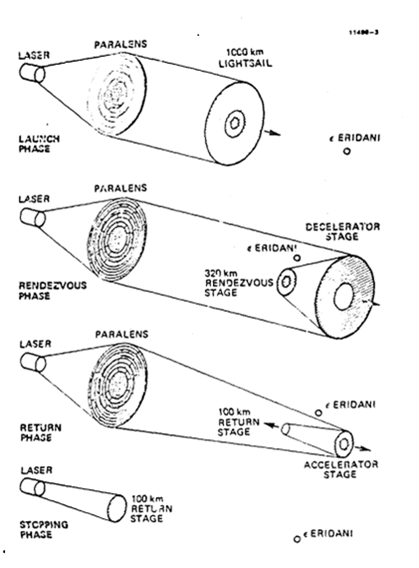
Image: Forward’s separable sail concept used for deceleration, from his paper “Roundtrip Interstellar Travel Using Laser-Pushed Lightsails,” Journal of Spacecraft and Rockets 21 (1984), pp. 187-195. The ‘paralens’ in the image is a huge Fresnel lens made of concentric rings of lightweight, transparent material, with free space between the rings and spars to hold the vast structure together, all of this located between the orbits of Saturn and Uranus. Study the diagram and you’ll see that the sail has three ring segments, each of them separating to provide a separate source of braking or acceleration for the arrival, respectively, and departure of the crew. Imagine the laser targeting this would require. Credit: Robert Forward.
I tend to think that Les Johnson is right about sails as they fit into the interstellar picture. In a recent interview with a publication called The National, Johnson (NASA MSFC) made the case that we might well reach another star with a sail driven by a laser. Breakthrough Starshot, indeed, continues to study exactly that concept, using a robotic payload miniaturized for the journey and sent in swarms of relatively small sails driven by an Earth-based laser. But when it comes to human missions to even nearby stars, Johnson is more circumspect. Let me quote him on this from the article:
“As for humans, that’s a lot more complicated because it takes a lot of mass to keep a group of humans alive for a decade-to centuries-long space journey and that means a massive ship. For a human crewed ship, we will need fusion propulsion at a minimum and antimatter as the ideal. While we know these are physically possible, the technology level needed for interstellar travel seems very far away – perhaps 100 to 200 years in the future.”

Johnson’s background in sail technologies for both near and deep space at Marshall Space Flight Center is extensive. Indeed, there was a time when his business card described him as ‘Manager of Interstellar Propulsion Technology Research’ (he once told me it was “the coolest business card ever”). He has also authored (with Gregory Matloff and Giovanni Vulpetti), books like Solar Sails: A Novel Approach to Interstellar Travel (Springer, 2014) and A Traveler’s Guide to the Stars (Princeton University Press, 2022), as well as editing the recent Interstellar Travel: Purpose and Motivations (Elsevier, 2023). In addition to that, his science fiction novels have explored numerous deep space scenarios.
Image: NASA’s Les Johnson, a prolific author and specialist in sail technologies. Credit: NASA.
So there’s a much more optimistic take on the human interstellar guideline than the one I gave in my first paragraph, and of course I hope it’s on target. We’re probably not going to be going to what is sometimes called an “Earth 2.0,” in Johnson’s view, because he doubts there are any such reasonably close to us. That’s something we’ll be learning a great deal more about as future space instrumentation comes online, but we can bear in mind that the explorers who tackled the Pacific in the great era of sail didn’t set out thinking they were going to find another Europe, either. The point is to explore and to learn what you can, with all the unexpected benefits that brings.
Johnson’s early interest in sails, by the way, was fired not so much by Forward’s Rocheworld as by Larry Niven and Jerry Pournelle’s novel The Mote in God’s Eye (Simon & Schuster, 1974), where an incoming laser sail from another civilization is detected. The realization that unusual astronomical observations point to a technology, and a laser-beaming one at that, is an exciting part of the book. Here the authors’ human starship crew describes the detection of a strange light emanating from a smaller star (the Mote) in front of a much larger supergiant (the Eye):
“…I checked with Commander Sinclair. He says his grandfather told him the Mote was once brighter than Murcheson’s Eye, and bright green. And the way Gavin’s describing that holo – well, sir, stars don’t radiate all one color. So -”
“All the more reason to think the holo was retouched. But it is funny, with that intruder coming straight out of the Mote…”
“Light,” Potter said firmly.
“Light sail!” Rod shouted in sudden realization…”
For more on all this, see my Our View of a Decelerating Magsail in these pages. It’s not surprising that Niven and Pournelle ran their lightsail concept past Robert Forward at a time when the idea was just gaining traction. We all have career-changing literary experiences. I can remember how a childhood reading of Poul Anderson’s The Enemy Stars (J.B. Lippincott, 1959) utterly fired my imagination toward the idea of leaving the Solar System entirely. It was a finalist for the Hugo Award that year following serialization in Astounding, though I didn’t encounter it until later.
Johnson’s work at Marshall Space Flight Center takes in the deployment of a large solar sail quadrant for the Solar Cruiser mission that was first unfurled in 2022 to demonstrate TRL 5 capability, and has just been deployed at contractor Redwire Corp.’s facility in Longmont, Colorado to demonstrate TRL 6. In NASA’s terms, that means going from “Component or breadboard validation in relevant environment” (TRL 5) to “System or subsystem model or prototype demonstration in a relevant environment (ground or space).” In other words, this is progress. At TRL 6, a system is considered “a fully functional prototype or representational model.” Says Johnson in a recent email:
“25 years ago, when I first met Dr. Forward, he inspired me to plan a development program for solar sails that would eventually lead us to the stars. With Bob’s help, I laid out a milestone driven roadmap that began with the space flight of a 10 m² solar sail, which we did in 2010 with NanoSail-D.
“Next on the plan was the development of something an order of magnitude larger. This was achieved with the development and launch of the 86 m² Near Earth Asteroid Scout solar sail in 2022 and the soon to be launched ACS-3 sail. The Solar Cruiser sail is an order of magnitude larger still at 1653 Square meters. The next step is 10,000!”
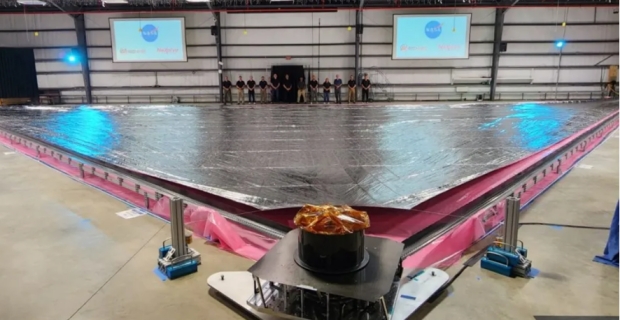
Image: NASA and industry partners used two 100-foot lightweight composite booms to unfurl the 4,300-square-foot sail quadrant for the first time Oct. 13, 2022, at Marshall Space Flight Center, making it the largest solar sail quadrant ever deployed at the time. On Jan. 30, 2024, NASA cleared a key technology milestone, demonstrating TRL6 capability at Redwire’s new facility in Longmont, Colorado, with the successful deployment of one of four identical solar sail quadrants. Credit: NASA (although I’ve edited the caption slightly to reflect the TRL level reached).
Solar sails are becoming viable choices for space missions, and the Breakthrough Starshot investigations remind us that sails driven not just by sunlight but by lasers are within the bounds of physics. A key question that will be informed by our experience with solar sails is how laser-driven techniques scale. Theoretically, they seem to scale quite well. Are the huge structures Forward once wrote about remotely feasible (perhaps via nanotech construction methods), or is Johnson right that fusion and one day antimatter may be necessary for craft large enough (and fast enough) to carry human crews?

Otto Struve: A Prescient Look at Exoplanet Detection
Some things just run in families. If you look into the life of Otto Struve, you’ll find that the Russian-born astronomer was the great grandson of Friedrich Georg Wilhelm von Struve, who was himself an astronomer known for his work on binary stars in the 19th Century. Otto’s father was an astronomer as well, as was his grandfather. That’s a lot of familial energy packed into the study of the stars, and the Struve of most recent fame (Otto died in 1963) drew on that energy to produce hundreds of scientific papers. Interestingly, the man who was director at Yerkes and the NRAO observatories was also an early SETI advocate who thought intelligence was rife in the Milky Way.

Of Baltic-German descent, Otto Struve might well have become the first person to discover an exoplanet, and therein hangs a tale. Poking around in the history of these matters, I ran into a paper that ran in 1952 in a publication called The Observatory titled “Proposal for a Project of High-Resolution Stellar Radial Velocity Work.” Then at UC Berkeley, Struve had written his PhD thesis on the spectroscopy of double star systems at the University of Chicago, so his paper might have carried more clout than it did. On the other hand, Struve was truly pushing the limits.
Image: Astronomer Otto Struve (1897-1963). Credit: Institute of Astronomy, Kharkiv National University.
For Struve was arguing that Doppler measurements – measuring the wavelength of light as a star moves toward and then away from the observer – might detect exoplanets, if they existed, a subject that was wildly speculative in that era. He was also saying that the kind of planet that could be detected this way would be as massive as Jupiter but in a tight orbit. I can’t call this a prediction of the existence of ‘hot Jupiters’ as much as a recognition that only that kind of planet would be available to the apparatus of the time. And in 1952, the idea of a Jupiter-class planet in that kind of orbit must have seemed like pure science fiction. And yet here was Struve:
…our hypothetical planet would have a velocity of roughly 200 km/sec. If the mass of this planet were equal to that of Jupiter, it would cause the observed radial velocity of the parent star to oscillate with a range of ± 0.2 km/sec—a quantity that might be just detectable with the most powerful Coudé spectrographs in existence. A planet ten times the mass of Jupiter would be very easy to detect, since it would cause the observed radial velocity of the star to oscillate with ± 2 km/sec. This is correct only for those orbits whose inclinations are 90°. But even for more moderate inclinations it should be possible, without much difficulty, to discover planets of 10 times the mass of Jupiter by the Doppler effect.
Struve suggested that binary stars would be a fertile hunting ground, for the radial velocity of the companion star would provide a “reliable standard of velocity.”
Imagine what would have happened if the discovery of 51 Pegasi (the work of Michel Mayor and Didier Queloz in 1995) had occurred in the early 1960s, when it was surely technically possible. Joshua Winn (Princeton University) speculates about this in his book The Little Book of Exoplanets (Princeton University Press, 2023). And if you start going down that road, you quickly run into another name that I only recently discovered, that of Kaj Aage Gunnar Strand (1907-2000). Working at Sproul Observatory (Swarthmore College) Strand announced that he had actually discovered a planet orbiting 61 Cygni in 1943. Struve considered this a confirmed exoplanet.
Now we’re getting deep into the weeds. Strand was using photometry, as reported in his paper “61 Cygni as a Triple System.” In other words, he was comparing the positions of the stars in the 61 Cygni binary system to demonstrate that they were changing over time in a cycle that showed the presence of an unseen companion. Here I’m dipping into the excellent Pipettepen site at the University of North Carolina, where Mackenna Wood has written up Strand’s work. And as Wood notes, Strand was limited to using glass photographic plates and a ruler to make measurements between the stars. Here’s the illustration Wood ran showing how tricky this would have been:

Image: An example of a photographic plate from one of the telescopes used in the 1943 61 Cygni study. The plate is a negative, showing stars as black dots, and empty space in white. Brighter stars appear as larger dots. Written at the bottom of the plate are notes indicating when the image was taken (Nov. 10, 1963), and what part of the sky it shows. Credit: Mackenna Wood.
Strand’s detection is no longer considered valid because more recent papers using more precise astrometry have found no evidence for a companion in this system. And that was a disappointment for readers of Arthur C. Clarke, who in his hugely exciting The Challenge of the Spaceship (1946) had made this statement in reference to Strand: “The first discovery of planets revolving around other suns, which was made in the United States in 1942, has changed all ideas of the plurality of worlds.”

Can you imagine the thrill that would have run up the spine of a science fiction fan in the late 1940s when he or she read that? Someone steeped in Heinlein, Asimov and van Vogt, with copies of Astounding available every month on the newsstand and the great 1950s era of science fiction about to begin, now reading about an actual planet around another star? I have a lot of issues of Astounding from the late 1930s in my collection though few from the late ‘40s, but I plan to check on Strand’s work to see if it appeared in any fashion in John Campbell’s great magazine in the following decade. Surely there would have been a buzz at least in the letter columns.
Image: Kaj Aage Gunnar Strand (1907-2000) was director of the U.S. Naval Observatory from 1963 to 1977. He specialized in astrometry, especially work on double stars and stellar distances. Credit: Wikimedia Commons / US Navy.

We’re not through with early exoplanet detection yet, though, and we’re staying at the same Sproul Observatory where Strand did the 61 Cygni work. It was in 1960 that another Sproul astronomer, Sarah Lippincott, published work arguing that Lalande 21185 (Gliese 411) had an unseen companion, a gas giant of ten Jupiter masses. A red dwarf at 8.3 light years out, this star is actually bright enough to be seen with even a small telescope. And in fact it does have two known planets and another candidate world, the innermost orbiting in a scant twelve days with a mass close to three times that of Earth, and the second on a 2800-day orbit and a mass fourteen times that of Earth. The candidate planet, if confirmed, would orbit between these two.
Image: Swarthmore College’s Sarah Lippincott, whose work on astrometry is highly regarded, although her exoplanet finds were compromised by faulty equipment. Credit: Swarthmore College.

The work on Lalande 21185 in exoplanet terms goes back to Peter van de Kamp, who proposed a massive gas giant there in 1945. Lippincott was actually one of van de Kamp’s students, and the duo used astrometrical techniques to study photographic plates taken at Sproul. It turns out that Sproul photographic plates taken at the same time as those Lippincott used in her later paper on the star were later used by van de Kamp in his claim of a planetary system at Barnard’s Star. It was demonstrated later that the photographic plates deployed in both studies were flawed. Systematic errors in the calibration of the telescope were the culprit in the mistaken identifications.
Image: Astronomer Peter van de Kamp (1901-1995). Credit: Rochester Institute of Technology newsletter.
We always knew that exoplanet hunting would push us to the limits, and today’s bounty of thousands of new worlds should remind us of how the landscape looked 75 years ago when Otto Struve delved into detection techniques using the Doppler method. At that time, as far as he knew, there was only one detected exoplanet, and that was Strand’s detection, which as we saw turned out to be false. But Struve had the method down if hot Jupiters existed, and of course they do. He also reminded us of something else, that a large enough planet seen at the right angle to its star should throw a signal:
There would, of course, also be eclipses. Assuming that the mean density of the planet is five times that of the star (which may be optimistic for such a large planet) the projected eclipsed area is about 1/50th of that of the star, and the loss of light in stellar magnitudes is about 0.02. This, too, should be ascertainable by modern photoelectric methods, though the spectrographic test would probably be more accurate. The advantage of the photometric procedure would be its fainter limiting magnitude compared to that of the high-dispersion spectrographic technique.
There, of course, is the transit method which has proven so critical in fleshing out our catalogs of exoplanets. Both radial velocity and transit techniques would prove far more amenable to early exoplanet detection than astrometry of the sort that van de Kamp and Lippincott used, though astrometry definitely has its place in the modern pantheon of detection methods. Back in 1963, when van de Kamp announced the discovery of what he thought were planets at Barnard’s Star, he relied on almost half a century of telescope observations to build his case. No one could fault his effort, and what a shame it is that the astronomer died just months before the discovery of 51 Pegasi b. It would be fascinating to have his take on all that has happened since.

What We Know Now about TRAPPIST-1 (and what we don’t)
Our recent conversations about the likelihood of life elsewhere in the universe emphasize how early in the search we are. Consider recent work on TRAPPIST-1, which draws on JWST data to tell us more about the nature of the seven planets there. On the surface, this seven-planet system around a nearby M-dwarf all but shouts for attention, given that we have three planets in the habitable zone, all of them of terrestrial size, as indeed are all the planets in the system. Moreover, as an ultracool dwarf star, the primary is both tiny and bright in the infrared, just the thing for an instrument like the James Webb Space Telescope to harvest solid data on planetary atmospheres.
This is a system, in other words, ripe for atmospheric and perhaps astrobiological investigation, and Michaël Gillon (University of Liége), the key player in discovering its complexities, points in a new paper to how much we’ve already learned. If its star is ultracool, the planetary system at TRAPPIST-1 can also be considered ‘ultracompact’ in that the innermost and outermost planets orbit at 0.01 and 0.06 AU respectively. By comparison, Mercury orbits at 0.4 AU from our Sun. The stability of the system through mean motion resonances means that we’re able to deduce tight limits on mass and density, which in turn give us useful insights into their composition.
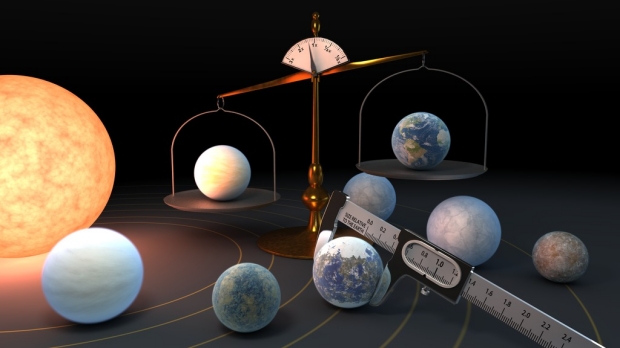
Image: Measuring the mass and diameter of a planet reveals its density, which can give scientists clues about its composition. Scientists now know the density of the seven TRAPPIST-1 planets with a higher precision than any other planets in the universe, other than those in our own solar system. Credit: NASA/JPL-Caltech/R. Hurt (IPAC).
Because we’ve been talking about SETI recently, I’ll mention that the SETI Institute has already subjected TRAPPIST-1 to a search using the Allen Telescope Array at frequencies of 2.84 and 8.2 gigahertz. The choice of frequencies was dictated by the researchers’ interest in whether a system this compact might have a civilization that had spread between two or more worlds. Searching for powerful broadband communications when planetary alignments between two habitable planets occur as viewed from Earth is thus a hopeful strategy, and as is obvious, the search yielded nothing unusual. A broader question is whether life might spread between such worlds through impacts and subsequent contamination.
What I’m angling for here is the relationship between a bold, unlikely observing strategy and a more orthodox study of planetary atmospheres. Both of these are ongoing, with the investigation of biosignatures a hot topic as we work with JWST but also plan for subsequent space telescopes like the Habitable Exoplanet Observatory (HabEx). The gap in expectations between SETI at TRAPPIST-1 and atmosphere characterization via such instruments highlights what a shot in the dark SETI can be. But it’s a useful shot in the dark. We need to know that there is a ‘great silence’ and continue to poke into it even as we explore the likelihood of abiogenesis elsewhere.
But back to the Gillon paper. Here you’ll find the latest results on planetary dynamics at TRAPPIST-1 and the implications for how these worlds form, along with current data on their densities and compositions. Another benefit of the compact nature of this system is that the planets interact with each other, which means we get strong signals from Transit Timing Variations that help constrain the orbits and masses involved. No other system has rocky exoplanets with such tight density measurements. The three inner planets are irradiated beyond the runaway greenhouse limit, and recent work points to the two inner planets being totally desiccated, with volatiles likely in the outer worlds.
What we’d like to know is whether, given that habitable zone planets are found in M-dwarf systems (Proxima Centauri is an obvious further example), such worlds can maintain a significant atmosphere given irradiation from the parent star. This is tricky work. There are models of the early Earth that involve massive volatile losses, and yet today’s Earth is obviously life supporting. Is there a possibility that rocky planets around M-dwarfs could begin with a high volatile content to counterbalance erosion from stellar bombardment? Gillon sees TRAPPIST-1 as an ideal laboratory to pursue such investigations, one with implications for M-dwarfs throughout the galaxy. From the paper:

Indeed, its planets have an irradiation range similar to the inner solar system and encompassing the inner and outer limits of its circumstellar habitable zone, with planet b and h receiving from their star about 4.2 and 0.15 times the energy received by the Earth from the Sun per second, respectively. Detecting an atmosphere around any of these 7 planets and measuring its composition would be of fundamental importance to constrain our atmospheric evolution and escape models, and, more broadly, to determine if low-mass M-dwarfs, the larger reservoir of terrestrial planets in the Universe, could truly host habitable worlds.
Image: Belgian astronomer Michaël Gillon, who discovered the planetary system at TRAPPIST-1. Credit: University of Liége.
Thus the early work on TRAPPIST-1 atmospheres, conducted with Hubble data and sufficient to rule out the presence of cloud-free hydrogen-dominated atmospheres for all the planets in the system. But now we have early papers using JWST data, and the issues become more stark when we turn to work performed by Gwenaël Van Looveren (University of Vienna) and colleagues. While previous studies of the system have indicated no thick atmospheres on the two innermost planets (b and c), the Van Looveren team focuses specifically on thermal losses occurring as the atmosphere heats as opposed to hard to measure non-thermal processes like stellar winds.
Here the situation clarifies. Working with computer code called Kompot, which calculates the thermo-chemical structure of an upper atmosphere, the team has analyzed the highly irradiated TRAPPIST-1 environment, modeling over 500 photochemical reactions in light of X-Ray, ultraviolet and infrared radiation, among other factors. The results show strong atmospheric loss in the early era of system development, but take into account losses through the different stages of the system’s evolution. It’s important to keep in mind that a star like this takes between 1 and 2 billion years to settle onto the main sequence, a period of high radiation. It’s also true that even main-sequence M-dwarfs can show high levels of radiation activity.
The upshot: X-ray and UV activity declines very slowly in the first several billion years on the main sequence, and stellar radiation in these wavelengths is the main driver of atmospheric loss. Things look dicey for atmospheres on any of the TRAPPIST-1 planets, and the Van Looveren model generalizes to other stars. From the paper:
The results of our models tentatively indicate that the habitable zone of M dwarfs after their arrival on the main sequence is not suited for the long-term survival of secondary atmospheres around planets of the considered planetary masses owing to the high ratio of spectral irradiance of XUV to optical/infrared radiation over a very long time compared to more massive stars. Maintaining atmospheres on planets like this requires their continual replenishment or their formation very late in the evolution of the planets. A further expansion of the grid and more detailed studies of the parameter space are required to draw definitive conclusions for the entire spectral class of M dwarfs.
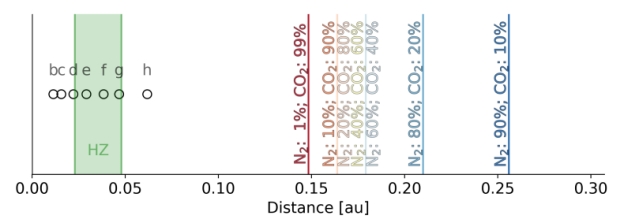
Image: This is Figure 8 from the paper. Caption: Overview of the planets in the TRAPPIST-1 system and the estimated habitable zone (indicated by the green lines, taken from Bolmont et al. 2017). We added vertical lines at the minimum distances at which atmospheres of various compositions could survive for more than 1 Gyr. Credit: Van Looveren et al.
Note the term ‘primary atmosphere.’ Primary atmospheres of hydrogen and helium give way to secondary atmospheres that are the result of later processes like volcanic outgassing and molecules breaking down under stellar radiation on the planet’s surface. The paper, then, is saying that the kind of secondary atmospheres in which we might hope to find life are unlikely to survive in this environment, although active processes on a given planet might still allow them. The paper ends this way:
Our conclusion from this work is therefore significant for terrestrial planets with a mass that is similar to the Earth’s mass that orbit mid- to late-M dwarfs such as TRAPPIST-1 near or inside the (final) habitable zone. For these planets, substantial N2/CO2 atmospheres are unlikely unless atmospheric gas is continually replenished at high rates on timescales of no more than a few million years (the loss timescales estimated in our work), for example, through volcanism.
I wouldn’t call this the death knell for atmospheric survival at TRAPPIST-1, nor do the authors, but the work points to the factors that have to be addressed in further study of the system, and the results certainly challenge the possibility of life-sustaining atmospheres on any of these planets. The Van Looveren work isn’t included in Michaël Gillon’s paper, which appeared just before its release, but I hope you’ll look at both and keep the Gillon available as the best current overview of TRAPPIST-1.
As to M-dwarf prospects in general, it’s one thing to imagine a high-radiation environment, with the possibilities that life might find an evolutionary path forward, but quite another to strip a planet of its atmosphere altogether. If that is the prospect, then the census of ‘habitable’ worlds drops sharply, for M-dwarfs make up somewhere around 80 percent of all the stars in the Milky Way. A sobering thought to close the morning as I head upstairs to grind coffee beans and rejuvenate myself with caffeine.
The papers are Gillon, “TRAPPIST-1 and its compact system of temperate rocky planets,” to be published in Handbook of Exoplanets (Springer) and available as a preprint. The Van Looveren paper is “Airy worlds or barren rocks? On the survivability of secondary atmospheres around the TRAPPIST-1 planets,” accepted at Astronomy & Astrophysics (preprint).


